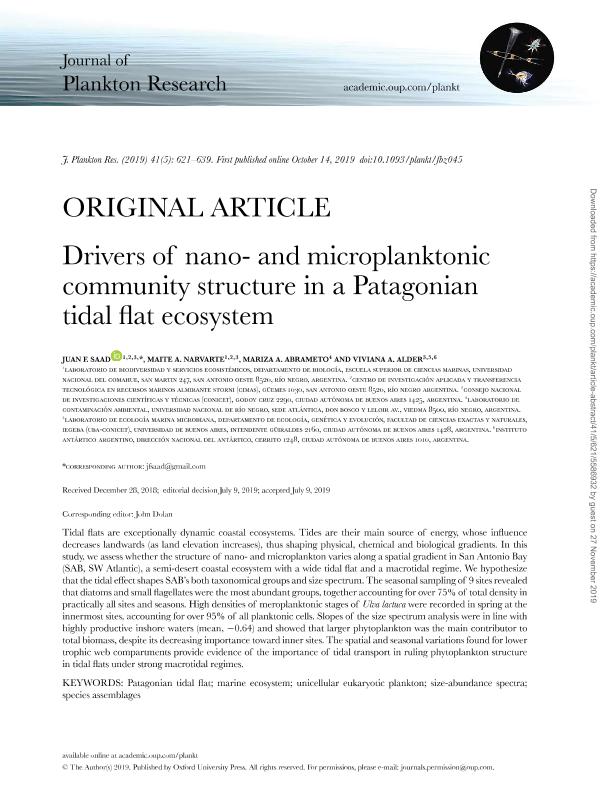Artículo
Drivers of nano- and microplanktonic community structure in a Patagonian tidal flat ecosystem
Fecha de publicación:
09/2019
Editorial:
Oxford University Press
Revista:
Journal of Plankton Research
ISSN:
0142-7873
Idioma:
Inglés
Tipo de recurso:
Artículo publicado
Clasificación temática:
Resumen
Tidal flats are exceptionally dynamic coastal ecosystems. Tides are their main source of energy, whose influence decreases landwards (as land elevation increases), thus shaping physical, chemical and biological gradients. In this study, we assess whether the structure of nano- and microplankton varies along a spatial gradient in San Antonio Bay (SAB, SW Atlantic), a semi-desert coastal ecosystem with a wide tidal flat and a macrotidal regime. We hypothesize that the tidal effect shapes SAB’s both taxonomical groups and size spectrum. The seasonal sampling of 9 sites revealed that diatoms and small flagellates were the most abundant groups, together accounting for over 75% of total density in practically all sites and seasons. High densities of meroplanktonic stages of Ulva lactuca were recorded in spring at the innermost sites, accounting for over 95% of all planktonic cells. Slopes of the size spectrum analysis were in line with highly productive inshore waters (mean, −0.64) and showed that larger phytoplankton was the main contributor to total biomass, despite its decreasing importance toward inner sites. The spatial and seasonal variations found for lower trophic web compartments provide evidence of the importance of tidal transport in ruling phytoplankton structure in tidal flats under strong macrotidal regimes.
Archivos asociados
Licencia
Identificadores
Colecciones
Articulos(IEGEBA)
Articulos de INSTITUTO DE ECOLOGIA, GENETICA Y EVOLUCION DE BS. AS
Articulos de INSTITUTO DE ECOLOGIA, GENETICA Y EVOLUCION DE BS. AS
Citación
Saad, Juan Francisco; Narvarte, Maite Andrea; Abrameto, Mariza Alejandra; Alder, Viviana Andrea; Drivers of nano- and microplanktonic community structure in a Patagonian tidal flat ecosystem; Oxford University Press; Journal of Plankton Research; 41; 5; 9-2019; 621-639
Compartir
Altmétricas




